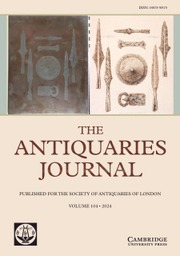No CrossRef data available.
Article contents
SWAT IN THE ASHMOLEAN: THE ITINERARY AND FATE OF THE BARGER GANDHARAN COLLECTION
Published online by Cambridge University Press: 04 September 2025
Abstract
Since its rediscovery in the context of nineteenth-century colonial India, the study of the ancient Buddhist sculpture of Gandhara (northern Pakistan) has been hampered by very limited information about the provenance of finds. This is the result of poorly documented expeditions by archaeologists and antiquarians, as much as the enduring appeal of classically-influenced Gandharan art to collectors. The present study casts light on the modern itineraries of antiquities recovered on the North-West Frontier of late colonial India with new discoveries about the extraordinary Evert Barger expedition of 1938.
Although it made a major contribution to the collections of the Victoria and Albert Museum in London, its nominal sponsor, the Barger expedition was characterised by a surprisingly haphazard and unstrategic approach, even by the standards of the day, and it straddled the diplomatically sensitive boundary between the official jurisdiction of British India and the princely state of Swat. By exploring new information about three Barger sculptures in the Ashmolean Museum in Oxford, two of which were previously unprovenanced, this study unpacks the complex history of the Barger antiquities, correcting past misapprehensions and adding depth to a story of colonial archaeology that has tended to rely on generalisations.
Keywords
Information
- Type
- Research paper
- Information
- Copyright
- © The Author(s), 2025. Published by Cambridge University Press on behalf of The Society of Antiquaries of London

